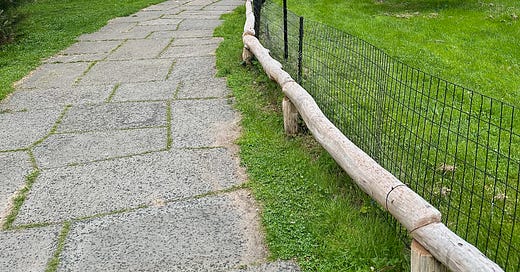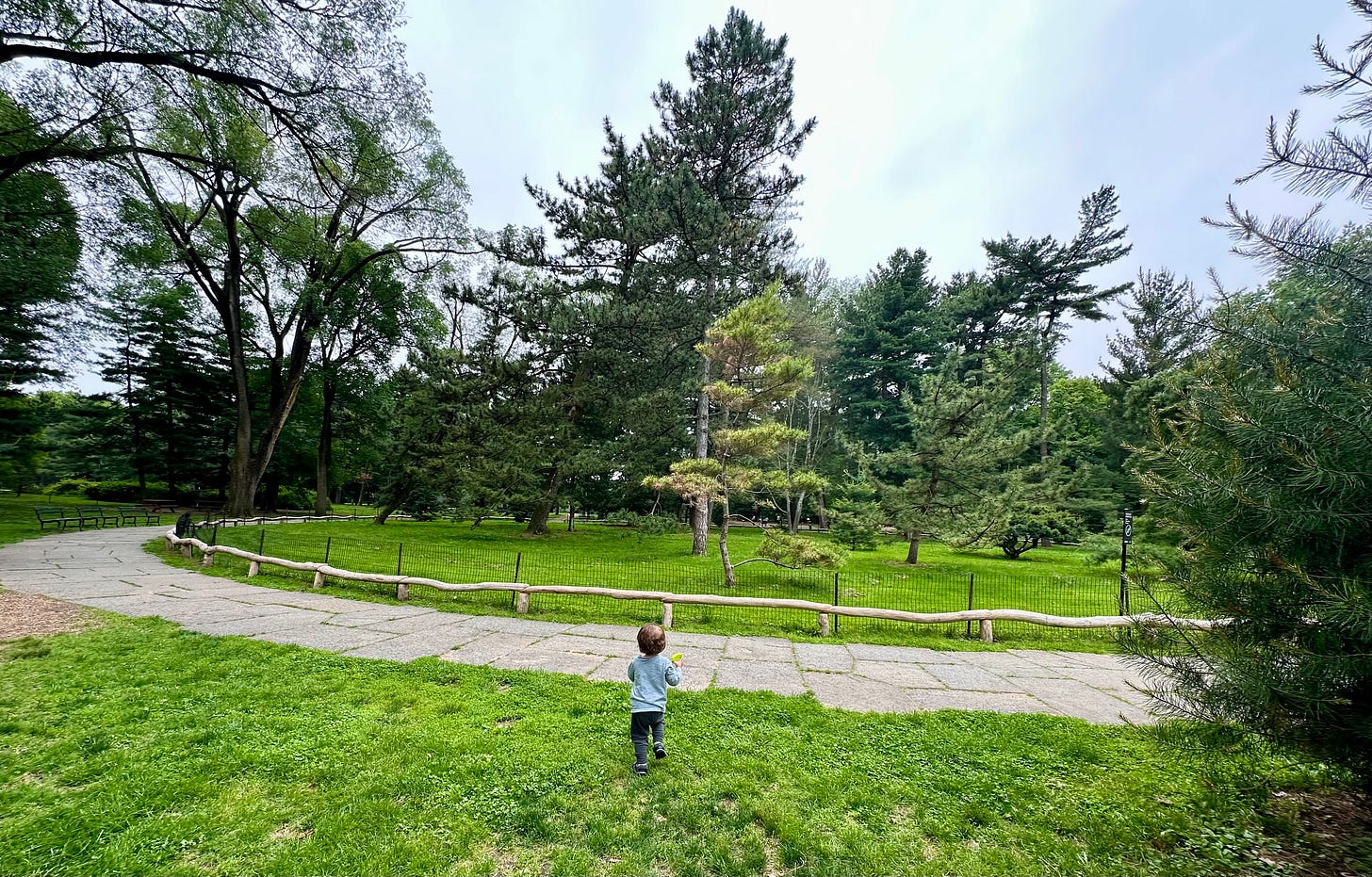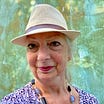Central Park's Continued Charm- Love and Growing Up Among the Trees.
A Place-Based Conversation and Prompt.
This post features an international and intergenerational collaboration with
, who publishes Place and Home Writing.Delving into our lived experience, we’ve come together in conversation to offer a personal perspective on place. Yasmin is a Writer and Mentor working with fiction and non-fiction writers. She lives in Scotland.
I’m a Writer, Expressive Writing/Journaling Teacher and Facilitator, and Creative Arts Therapist living in New York City.
We both have a deep love of place and all that it offers as a rich source for journaling and creative writing. When we were planning this collaboration we spoke about locations we both knew and decided that our first conversation would focus on Central Park.
We encourage you to write a sentence or create a short piece of writing in response. You can post it in the comments section on either, or both, of our posts. Check out the prompt below, and in Yasmin’s post here.
Here is my half of the conversation.
I’ve lived less than a ten-minute walk from Central Park for over ten years. While I’ve roamed through the park on occasion with friends, it wasn’t until the Pandemic and remote work that I began to fully appreciate, visit and explore this beauty in the center of Manhattan, New York.
I needed these breaks in nature as news of illness, death, loss and lockdowns around the world accumulated.
In Central Park, other New Yorkers and I would pass each other. Our eyes would meet to say, I see you too. There was a sense of we’re in this unknown, earth-shattering reality that feels like a science fiction film together, but, please, don’t get too close. Six feet apart.
I don’t know if you’re safe.
It was during this same period, pre-vaccines, that my now husband and I met in person, following text exchanges and phone calls.
We greeted each other for the first time wearing masks, opting for the eighty-first and Central Park West dirt path entrance with its canopy of trees and fallen petals below our feet.
We strolled through the park as if we were courting in another time, keeping a bit of distance between us as if there was a chaperone behind us ready to separate us if we got too close.
As we walked deeper into Central Park, near the Carousel, devoid of children’s sounds now, we sat on an empty and welcoming park bench, daring to get a bit closer.
By the end of the first date, after our side hug (COVID after all), I thought, this could really be something. I was no stranger to cautious optimism, but this felt different.
I’d already fallen in love with Central Park-more so as it became the backdrop for future dates (picnics, countless walks, exploring new parts of the park together). As care and authentic love blossomed for my partner, it bloomed in tandem for Central Park.
I can’t imagine our relationship unfurling without Central Park as a supporting character. The support of Central Park continues to evolve as I claim different parts of the park as the places I go to meditate or write, such as The Arthur Ross Pinetum, with its clustered Pine trees, surrounded by a circular steel-colored stone path, little bits of grass peeking out between the stones, and a low natural wood fence encircling the trees.
I used to visit the Pinetum with my infant son asleep in his bassinet. Sitting on a wood green park bench, I’d journal while taking in the scents of the Pines, moved by gentle breezes in spring, bundled up in the crisp air of winter.
As the seasons came and went and came again, my son is suddenly a toddler. Rather than asleep in his bassinet, walking becomes running around the circular path. He experiments with walking backwards, taking my hand so I’ll join him in the game. We wander off the path to one of the Pines on the side. On this day, my son has his water-filled spray bottle and shares a gentle spritz with the Pine and neighboring grass.
I anticipate future adventures sauntering through Central Park.
I come back to this moment with my son, a child full of wonder, enjoying every inch of the park we share with him. I drink in his ebullient spirit. I breathe in his joy, slowing down this moment in the park with him.
Central Park, with its grounding steadfast support unwavering while life speeds on. I wonder what mysteries and adventures it holds in our future.
If you can make it to Central Park, visit the Pinetum. Sit on a weathered green wooden bench. Close your eyes for a moment.
Breathe in the air.
Maybe I’ll see you there.
PROMPT!
Write about a park excursion, either solo or with friends or family. What made this trip stand out? What do you want to remember from this experience? Include sensory details (see, hear, taste, smell, feel/touch).
For more distance, write in third-person, for less, in first-person.
After your write: Read over what you wrote and write a reflection. This is a chance to step back and be open and curious to any insights or further learning from the experience.
Start with one of the following sentence starters. Fill in all that speak to you today.
As I read this, I feel… Notice where you feel this in your body and how it’s expressed (ex: an open expansion in your throat, a knot in your stomach, etc).
As I read this, I’m aware of…
As I read this, I’m curious about…
As I read this, I’m surprised by…
As I read this, my questions are…
If you’re comfortable, please share your writing here in the comments. We’d love to read it!
If you enjoyed reading this post, please give it a heart and restack to grow this community and spread the love. Thank you!
Before you go, hop on over to Yasmin’s part of the conversation (if you haven’t already:) here.
Till next time,
Jennifer








Jennifer, thank you for sharing your personal experience of Central Park. As you recount these moments in time, I'm taken back to the days when Covid-19 altered our lives dramatically. And, to think that your relationship blossomed during the restrictions... well, it's heartwarming for sure.
And, thank you for being my collaborative buddy for this project. It's been very rewarding to write with you, and produce two posts about Central Park, each filled with memories and love.
Jennifer and Yasmin...thank you. What a beautiful and inspiring collaboration. I'm going to take a risk and add what I just wrote about another NY park at another time...
The Red Coal
It is October 6. Thirty out of eighty students gather in a loft just belong Washington Square Park. The air, still dense. The smell sweet yet charred. Unfamiliar. The streets too quiet.
We have gathered to write with our teacher, Natalie Goldberg.
Natalie says, “Begin with…This much I do remember…Go…ten minutes.”
Natalie says, “Tell me about a street you lived on…Go...ten minutes.”
Natalie says, “Let’s do a RECALL from last time…”
Natalie says, “Write about what brings you joy…Go…ten minutes.”
We sit meditation. We write. We read aloud. We do Zen walking…slow, slow, slower…then fast, fast, faster.
We “crack open structure” by rearranging gray folding chairs, zafus and zabutons.
Neat, tidy rows disappear, replaced by random, yet comforting disorder. Everything seems difficult. Pens drag across paper.
Our writing is muffled, brittle, lifeless, cold. We know it. We trust the practice and wait.
Natalie says. ”Keep your hand moving; don’t cross out; be specific—not the flower in the window, the GARDENIA—ignore spelling and punctuation; you’re free to write the worst trash in America.”
Outside, the sky is an unnerving shade of gray. The windows are open. It’s the in between of summer and fall. Humid. No breeze. Some leaves are strangely brown.
Natalie says, “Get up. Follow me.”
She picks up the bell.
We follow. Single file down the stairwell, out the door. Slowly. Mindfully. Each step a prayer to a shattered world.
We move in silence. We move as one body.
We cut a diagonal across the mostly empty Washington Square Park.
People join us, wordless.
The muffled hum of the park settles.
We return to the loft.
Natalie reads The Red Coal by Gerald Stern.
It begins, “I sit in my blue chair trying to remember…before the burning coal entered my life.”
His ordinary statement captures us—we’re breathless. That coal burns our hands, our tongues, our bellies. Some of us swallow it whole, our hair is singed, and suddenly we’re on fire.
Natalie says, “What is the red coal in your life? Go. Ten minutes.”
We write frantically. Handwriting becomes large and loopy, indecipherable on the page, filled with urgency. We’re awake at last—as though hundreds of layers of fine gauze covering our eyes smolder on the floor.
We read; we cry, we laugh, we re-member. The practice restores, the poem revives us.
Natalie reminds us of Katagiri Roshi’s injunctions—“don’t be tossed away and continue under all circumstances.”
In the face of 9/11 we’ve tossed ourselves away.
And now, The Red Coal brings us back to life.
More than this, our humble teacher, has drawn on her deep practice and dharma wisdom to ride the rugged edge of our despair without any effort to change it. To continue under these circumstances, to demonstrate the power of practice.